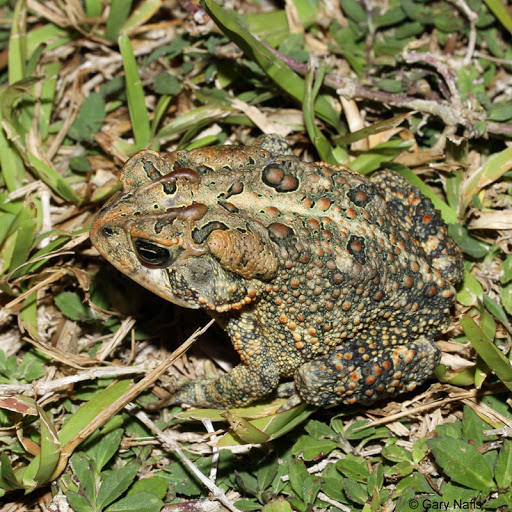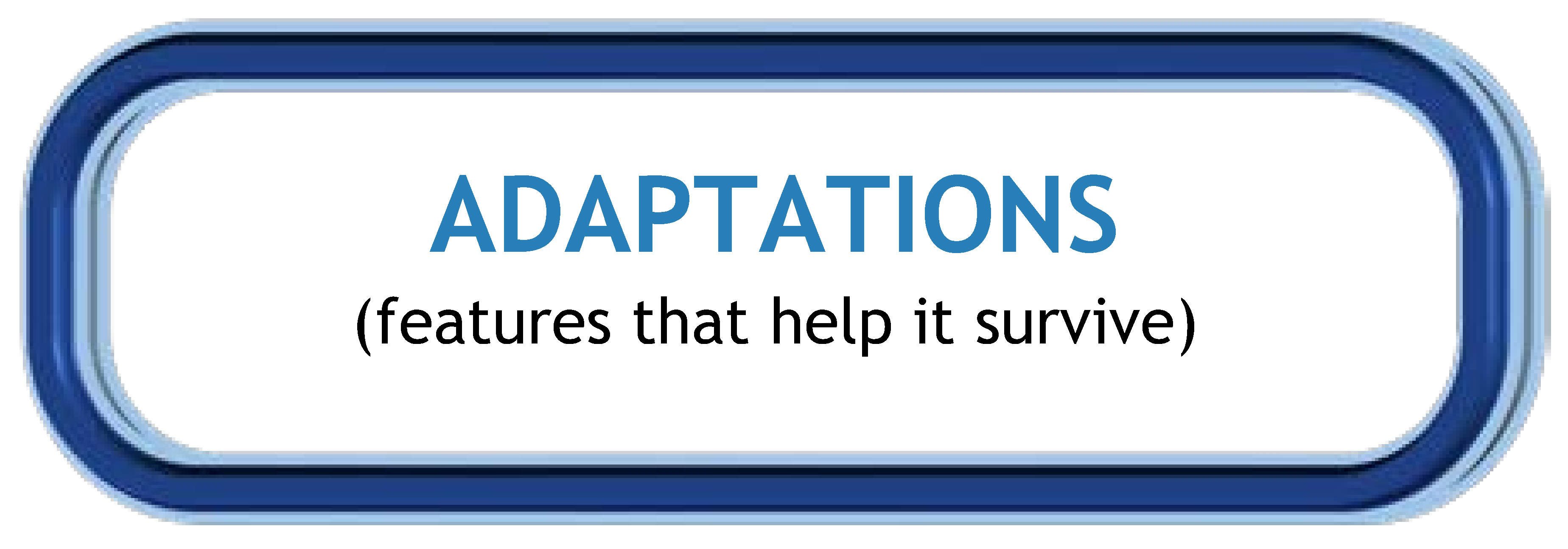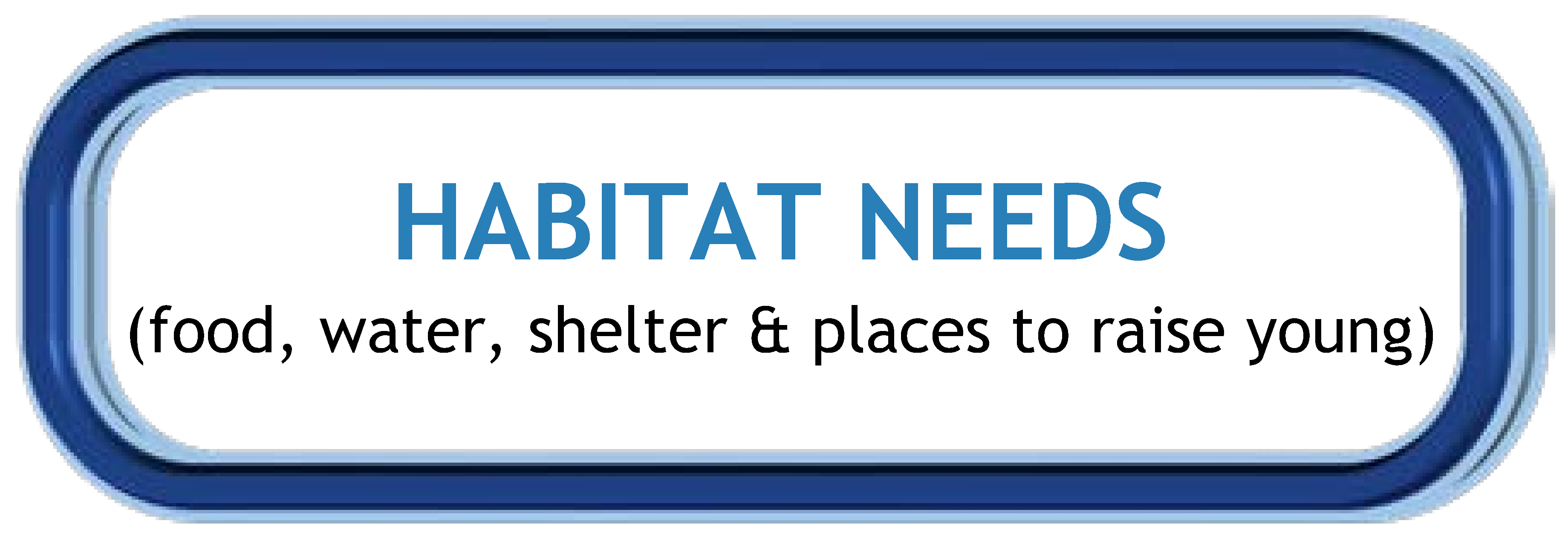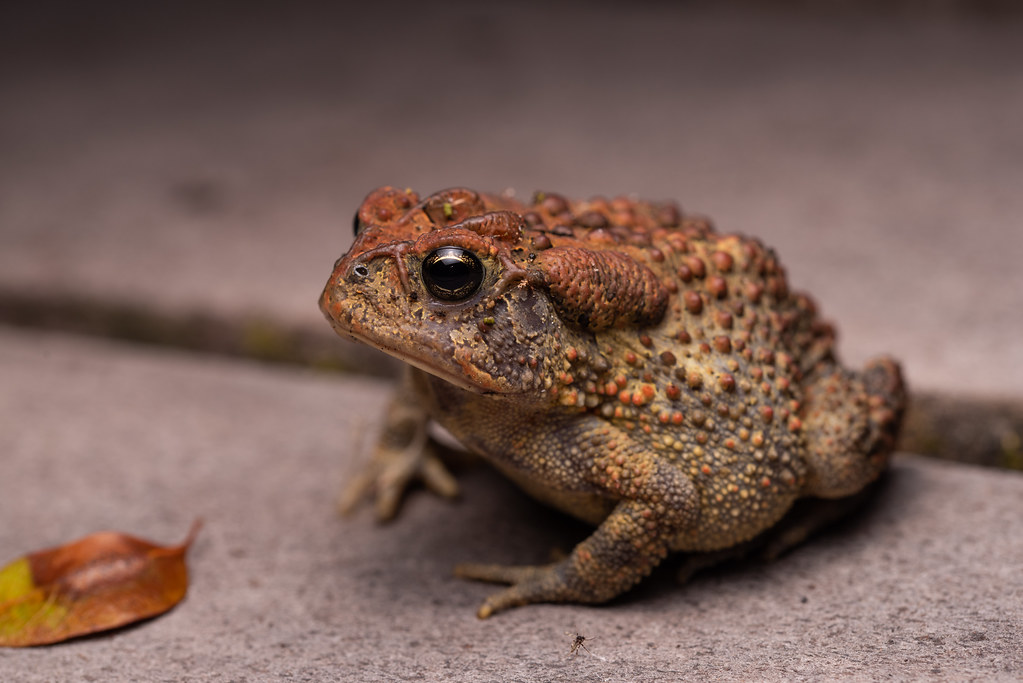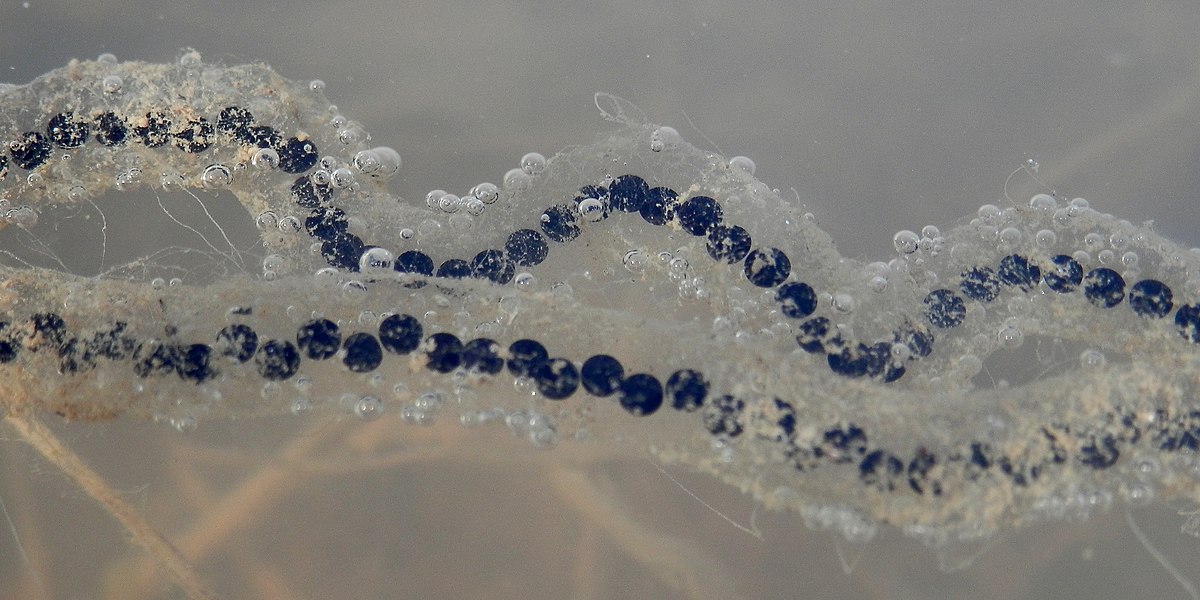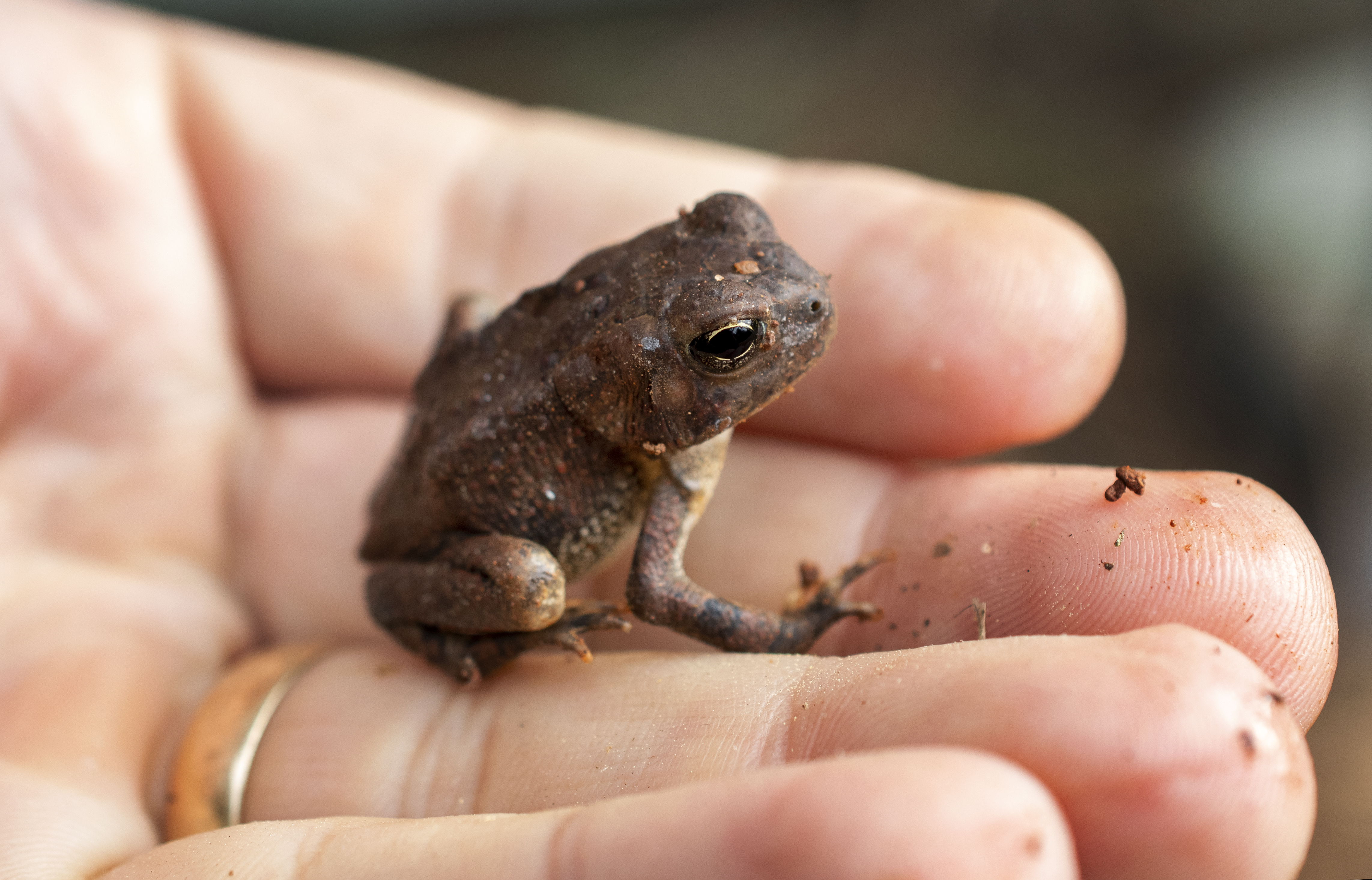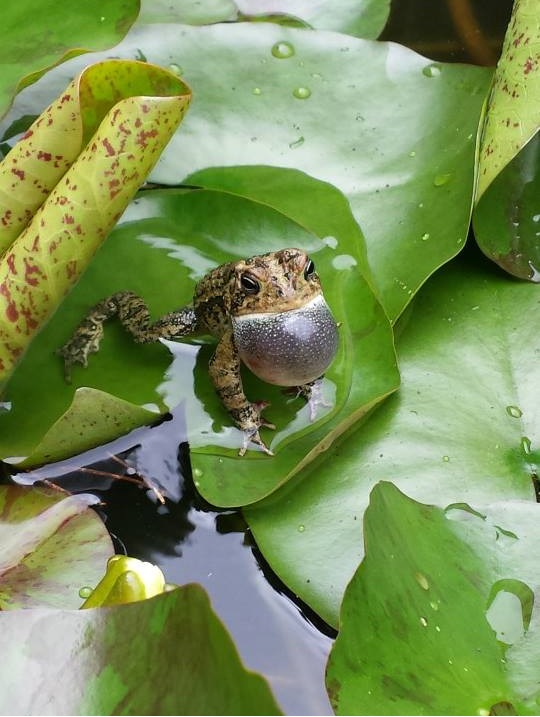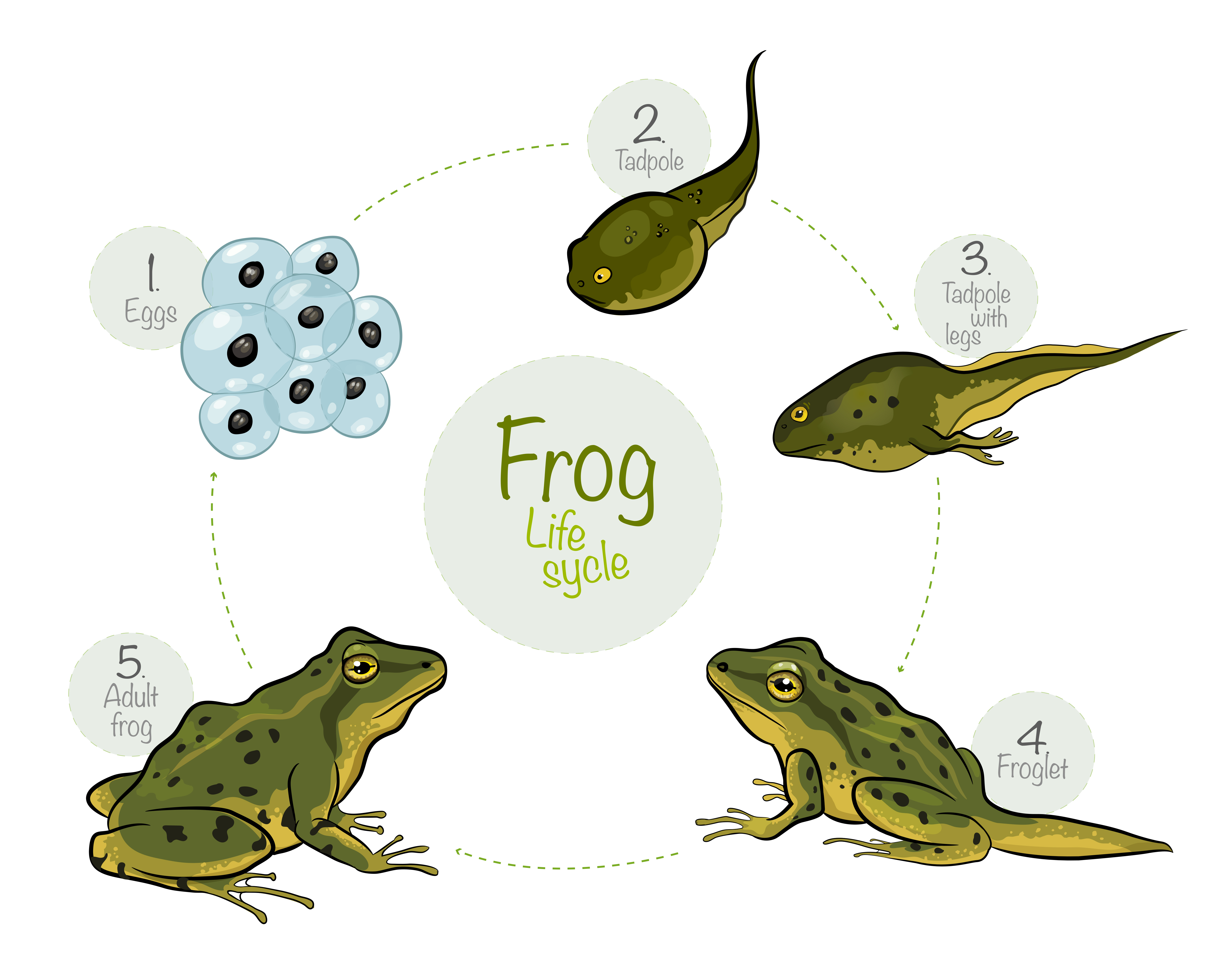Wonders of Wildlife: Southern Toad
Southern Toad
Scientific Name: Anaxyrus terrestris
Found in Alabama: Common in southern and western regions
Diet: Herbivore (eats plants) as tadpoles
Carnivore (eats animals) as adults
|
|
Southern Toad in Habitat
© Gary Nafis
Click image to enlarge it |
Learn more about...
| CLASSIFICATION |
|
What type of animal am I?
- I am a vertebrate (an animal with a spine or backbone).
- I am cold-blooded, so I cannot control my body temperature.
- I do not have scales, feathers, or fur, so I have smooth skin.
- When I am a larva (tadpole), I breathe using gills, and when I am an adult, I breathe using lungs.
- I have 4 legs.
|
Scientists use basic traits to group animals into different taxonomic classes.
For a taxonomic classification chart comparing key traits of common backyard wildlife,
CLICK HERE! |
|
| The Southern Toad is an AMPHIBIAN! |
| IDENTIFICATION TIPS |
|
Southern Toad
Flick - Patrick Randall
Click image to enlarge it
|
ADULT SOUTHERN TOAD |
- Body size ranges from 1.75 to 4 inches long
|
- Mostly brown but can appear gray, black, or reddish brown in coloration with dark spots and a light underside
|
- Warty looking skin with two kidney-shaped glands on the back of the neck
|
| |
|
|
|
EGGS
|
TADPOLES (Larvae)
|
TOADLETS
|
Roughly 1mm in diameter;
in long strand |
Average 6.5-11 mm in length
(less than 0.5 inches) |
Range from the size of the tadpoles to the size of the adults |
American Toad Egg Strand
(closely related species)
Ryan Hodnett - Wikimedia
Click image to enlarge it
|
Southern Toad Tadpole
Noah J. Mueller Ph.D.
Click image to enlarge it
|
American Toad Toadlet
(closely related species)
Dreamstime
Click image to enlarge it |
| ADAPTATIONS |
| |
| PHYSICAL ADAPTATIONS |
| |
| Southern toads avoid predators using camouflage: |
- A southern toad's brownish gray coloration allows it to easily blend in with the surrounding soil and leaf litter.
- This camouflage (ability to blend in to the surrounding environment) helps it to avoid being spotted by predators (animals that eat them) and other threats.
|
| |
| Southern toads defend themselves using a toxin: |
- Southern toads have two bean-shaped bumps on the back of the neck called paratoid glands.
- If approached by a threat, they use these glands to secrete a white fluid called bufotoxin.
- This toxin tastes bad and causes nausea and burning of the mauth for the animals that bite them.
- They are also able to avoid threats by inflating their lungs, making them appear larger.
|
| |
| Southern toads are sit-and-wait predators: |
- Southern toads can capture prey without having to run exceptionally quickly.
- When a prey item comes near a southern toad, it uses its long, sticky tongue to capture its prey.
- They also use their front legs to grab larger prey.
|
| |
| Sowler's toads have tongues that help them capture prey: |
- The tongue of a southern toad is long and is attached at the front of the mouth, allowing it to launch as far as possible to capture prey (animals they eat).
- Frog and toad tongues are made of extremely soft tissues, giving them the ability to hold on to the prey.
- Their tongues are not "sticky" like a piece of tape. Instead, their saliva is able to convert back and forth between a liquid watery texture and a thick, sticky texture.
- When a toad is at rest, the saliva is watery and not sticky. As a frog sticks out its tongue to capture prey (animal that it eats), the liquid saliva that surrounds the animal becomes thicker and stickier, trapping the animal.
- Once the animal is inside the toad's mouth, the frog uses its eyes to push against the food item to help release it from the tongue, allowing the frog to swallow its food.
|
| |
| |
| BEHAVIORAL ADAPTATIONS |
| |
| Southern toads are nocturnal: |
- They are active during the night (nocturnal).
|
| |
| Southern toads communicate with one another: |
Southern Toad Calling
Tyler Burgener
Click image to enlarge it
|
- When the weather begins to warm in the springtime, males move from terrestrial (land) habitats to small freshwater habitats.
- They make a high pitched trill call that lasts for about 2-8 seconds.
- Female southern toads recognize the sound and move toward those freshwater habitats.
|
| Southern toads use burrows to help regulate body temperature: |
- The southern toad is cold-blooded and does not produce its own body heat.
- During the day when they are less active, southern toads take cover under leaf litter or burrow into the soil. This keeps their body temperature cooler.
- They also use burrows in the colder winter months to enter an inactive state called torpor, similar to hibernation(becoming dormant as if it is in a deep sleep).
- They have a special hardened spade-like projection on each of their hind feet, allowing them to easily dig these burrows.
|
| LIFE CYCLE |
| |
|
|
Frog Life Cycle
Wikimedia - Derek Ramsey
Click image to enlarge it
|
|
Metamorphosis is the process of physical change that some animals go through as they transform from a larvae into an adult.
|
|
| |
|
|
|
| Four Life Cycle Stages of the Southern Toad |
| |
|
|
|
| 1. Egg: |
- Females lay around 2,500 soft-shelled eggs each breeding season.
- Eggs are laid in standing water where they form a jelly-like coil.
|
| 2. Tadpoles: |
- Baby toads that hatch from the eggs are called tadpoles.
- Once the larvae (tadpoles) emerge from the eggs, they are independent.
- Tadpoles live in an aquatic (water) habitat.
- Tadpoles do not have legs.
- They do not have lungs to breathe like we do. They have gills like fish for breathing.
|
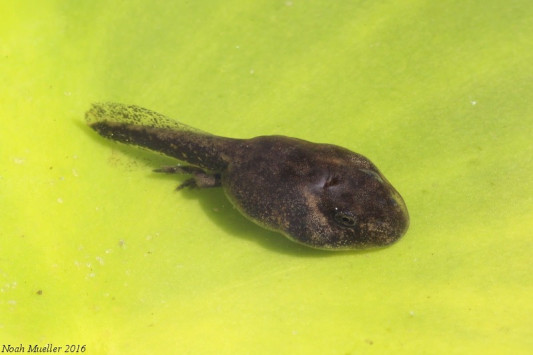 Southern Toad Tadpole Southern Toad Tadpole
Noah J. Mueller Ph.D.
Click image to enlarge it |
| 3. Toadlets: |
- As a tadpole undergoes metamorphosis (physical change) from tadpole to adult, it grows hind legs and front legs as the tail begins to shorten.
- The gills will reduce as the lungs begin to enlarge.
- During this transition, the southern toad goes through the toadlet stage where they begin to resemble the adult but have not fully developed all of the adult features.
|
| 4. Adult: |
- Adult southern toads have fully formed legs and are able to live on land.
|
American Toadlet
(closely related species)
Dreamstime
Click image to enlarge it
|
| Life Span: |
- The southern toad can live up to 10 years, but many will not live this long.
|
NATURAL
Habitat Needs |
ADULTS |
YOUNG |
| Food |
- Carnivores (eat animals).
- Feed on a variety of small invertebrates (animals without a backbone) including beetles, ants, cockroaches, crickets, and snails.
|
- Herbivores (eat plants).
- Feed on plants and algae in the water.
|
| Water |
- Toads do not drink water, but it is essential to keep their bodies moist and hydrated.
- Water habitats are used for hiding, and for reproduction.
|
- Tadpoles live in sources of standing water.
|
| Shelter |
- live in a variety of terrestrial (land) habitats that must be close to water.
- Will live in habitats such as agricultural fields, pine woodlands, and coastal scrub.
- Can live in many habitats but prefer sandy soils in which they can burrow.
|
- Tadpoles prefer standing water with vegetation (plants) and shallow portions where they can escape predators (animals that eat them).
|
| Places to Raise Young |
- Eggs are deposited into sources of standing water.
|
|
BACKYARD
Habitat Needs |
ADULTS |
YOUNG |
| Food |
- Provide a shallow pond that will attract insects that lay their eggs in water like dragonflies.
- Provide native grasses, wildflowers and shrubs that support insects and other invertebrates (animals that do not have a backbone).
- Do not spray pesticides that might harm insect populations.
- Do not remove leaf litter where insects can live.
- See AWF's Frog Habitat Project Plan for a list of materials & plant suggestions.
|
- Provide a water source such as a shallow pond that is able to support algae and aquatic vegetation (plants).
- Do not remove rocks, logs, or vegetation from standing sources of freshwater such as ponds or bogs.
|
| Water |
- Provide sources of standing water, like a pond or puddle stations.
|
| Shelter |
- Plant native grasses around water sources or bogs with a sandy substrate.
|
- Provide standing water with vegetation (plants) and shallow portions.
- Do not remove logs and rocks from water sources.
|
| Places to Raise Young |
- If a standing source of freshwater is not located nearby, create a bog or pond with standing water or a pond with vegetation (plants) where eggs can be deposited.
|
|
| ECOLOGICAL ROLE |
| |
|
| Animals play an important ecological role in the health of habitats and ecosystems. |
| |
|
Food Source: |
- Adult southern toads are consumed by a variety of snakes including hognose snakes, water snakes, indigo snakes, garter snakes, and black racers.
- Tadpoles are consumed by two toed amphiumas, lesser sirens, and dragonfly larvae.
|
| |
|
| Insect Population Control: |
- An adult toad can eat up to 1,000 insects each day.
- They are extremely important in controlling the insect populations in their surrounding habitat.
|
| |
|
Indicator Species: |
- The thin skin on adult southern toads and other amphibians makes them vulnerable to absorbing toxic materials and pollutants present in the environment.
- A decrease in population size might indicate an increase in harmful chemicals in an ecosystem.
|
INFORMATION SOURCES FOR THIS SPECIES
.
 Southern Toad Tadpole
Southern Toad Tadpole



 Wildlife Tag
Wildlife Tag
